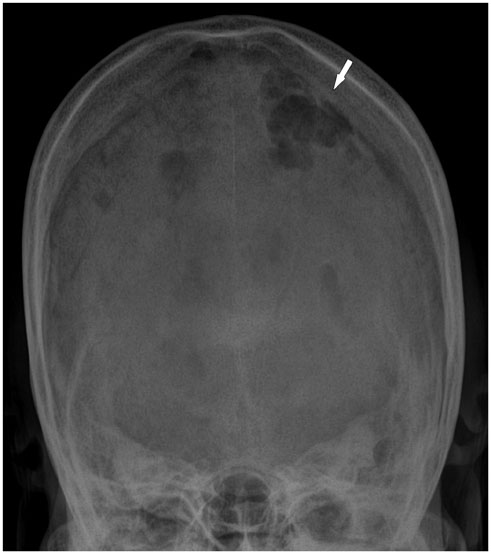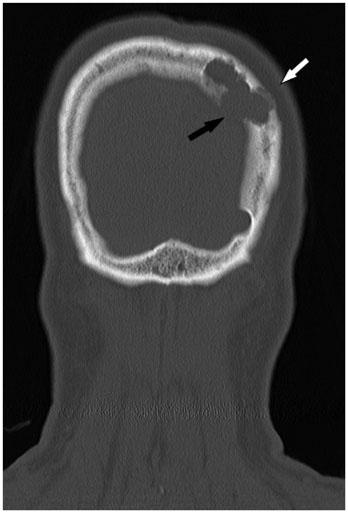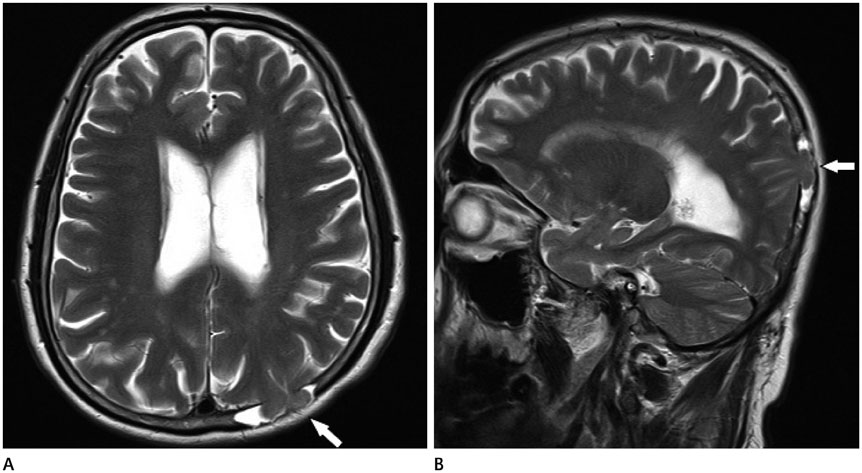J Korean Soc Radiol.
2015 Jun;72(6):423-426. 10.3348/jksr.2015.72.6.423.
Intradiploic Encephalocele of the Left Parietal Bone: A Case Report
- Affiliations
-
- 1Department of Neurosurgery, Myongji St. Mary's Hospital, Seoul, Korea. nshs@catholic.ac.kr
- 2Department of Radiology, Myongji St. Mary's Hospital, Seoul, Korea.
- KMID: 2098023
- DOI: http://doi.org/10.3348/jksr.2015.72.6.423
Abstract
- Encephaloceles are generally regarded as midline abnormalities. A 50-year-old man presented with a parietal intradiploic encephalocele manifesting as intermittent headache for the past 6 months. Computed tomography (CT) showed bone destruction associated with a left parietal lesion. Magnetic resonance imaging (MRI) demonstrated brain herniation within the intradiploic space. Cerebral angiographic imaging showed a normal cerebral vessel pattern within the herniated brain lesion. In this case, surgical treatment may not be necessary in the absence of concurrent symptoms and neurologic deficit. We report the CT, MRI, and angiographic findings of an extremely rare case of parietal intradiploic encephalocele in adulthood.
MeSH Terms
Figure
Reference
-
1. Kosnik EJ, Meagher JN, Quenemoen LR. Parietal intradiploic encephalocele. Case report. J Neurosurg. 1976; 44:617–661.2. Mealey J Jr, Dzenitis AJ, Hockey AA. The prognosis of encephaloceles. J Neurosurg. 1970; 32:209–218.3. Tsuboi Y, Hayashi N, Noguchi K, Kurimoto M, Nagai S, Endo S. Parietal intradiploic encephalocele--case report. Neurol Med Chir (Tokyo). 2007; 47:240–224.4. Sadler TW. Langman's medical embryology. 10th ed. Baltimore: Lippincott Williams & Wilkins;2006. p. 126–143. p. 286–317.5. Peters J, Raab P, Marquardt G, Zanella FE. Intradiploic meningoencephalocele. Eur Radiol. 2002; 12:Suppl 3. S25–S27.6. Dobrin N, Bălinişteanu M, Costăchescu B, Tudorache C, Chiriac A, Poeată I. Acquired parietal intradiploic encephalocele. Case report and review of the literature. Rom S Neurosurg. 2011; 18.7. Loumiotis I, Jones L, Diehn F, Lanzino G. Symptomatic left intradiploic encephalocele. Neurology. 2010; 75:1027.8. Kumar R, Chandra SP, Sharma BS. Giant intradiploic pseudomeningocele of occipital bone. J Neurosurg Pediatr. 2012; 9:82–85.





